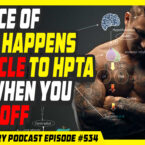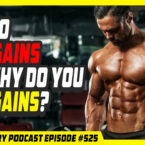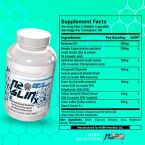Sign up to Get FREE Steroids, SARMS, Peptides eBooks
Ask any of the elite who has become truly massive beasts which anabolic substance has had the most profound effect upon their physique and the answer from the largest bodybuilders will unanimously be insulin. And here is the second of the two part excerpt "Big Fat Bastards and Insulin" from Chemical Muscle Enhancement by Author L. Rea. This excerpt is all about the various types of insulin and the protocol for using it for making the absolute most amazing gains possible. But watch out! Although highly anabolic to muscle, insulin is also highly anabolic to fat. So unless used correctly, bodybuilding's best muscle builder can turn you into a big fat bastard instead! It can also be deadly.
Please click here if you missed Big Fat Bastards and Insulin -- Part One. Or, please read on for part two.
Big Fat Bastards and Insulin -- Part Two
Nothing in this article is intended to take the place of advice from a licensed health professional. Consult a physician before taking any medication.
In relationship to goals it would seem evident that a protocol employing the attributes of insulin would necessitate the symbiotic relationship the hormone has with macronutrients as it applies to lean muscle mass tissue.
- Muscle is more than 80% protein by dry weight.
- ATP is the energy currency of muscular contractions, repair, and growth.
- Glucose is the prime source substrate for ATP synthesis and mandatory for proper brain and organ function (yes, that one also).
- Excess blood glucose will result in excess adipose tissue accumulation.
The Protocol
Diet
When this protocol was created its intent was rapid accumulation of lean mass tissue without an increase in adipose tissue deposits. Since the foundation of the diet was structured for efficient gluconeogenic dependant upon a correct ratio and amount of amino acids, a great deal of protein was consumed daily. The most effective protein intake minimum was the equivalent of 3 grams of protein per pound of bodyweight daily divided into at least 6 meals. Using a 200 pound individual as an example it was possible to reduce this slightly by simply eating 4 whole food meals daily providing 50 grams of whole protein each and sipping on whey protein drinks in water throughout the day
providing the remaining 400 grams of protein. I preferred whey protein simply because it is one of the only two drinkable products I am aware of that allows for actual hyperaminoacid response in the circulatory system. Casein, egg, and (some people still use it) soy proteins fail to clear the GI track at a rate significant enough to induce the necessary supraphysiological amino acid concentrations for the protocol. The fact that whey protein is easily oxidized by the liver should be the first clue to the reason why results are superior.
So here is the kicker. Though fat intake could be quite high, total daily carbohydrate intake could not exceed 0.5 grams per 25 pounds of bodyweight daily. The reason is simple: The goal was to force the body to employ the gluconeogenic pathway as a means of energy production. Any degree of actual glycogen regeneration resulted in the body returning to the glycosis pathway which allows for adipose tissue accumulation. The reason this worked so well was simplistic in nature. The making of ATP through amino acid gluconeogenesis is very inefficient thus allowing for a huge calorie expenditure similar to what occurs during DNP utilization. During calorie expenditure the body does not store fat but it does undergo protein anabolism. When enough protein was ingested the result was always a net increase in lean body mass of 5-8 pounds by the end of a two week protocol. Not bad for an experienced beasts, huh?
Additional Supplements
Since exogenous insulin was utilized during this protocol and, as mentioned prior, the gluconeogenic energy pathway loves certain amino acids it is easy to realize that the normal ratio of amino acids derived from whey protein and whole foods was not likely adequate. A mixture of 4 parts Alanine, 2 parts Glutamine, 2 parts Arginine and 1 part Taurine was created and capsulated. The dosage ingested was 1 gram of the supplemental mix per I.U. of insulin administered daily divided into 2 post administration dosages.
The preparation for this protocol required a liver glycogen depletion period of 24 hours prior to initial insulin administration. This was done to initiate the gluconeogenic pathway prior to protocol onset thus preventing any loss of lean tissue growth potential.
Though only a total idiot would ever assume that non-medical exogenous insulin use was safe, the utilization of a fast acting insulin was the better choice for this protocol. The first reason of course being that short acting chemistry also means shorter periods of potential exposure to negative side effects like a coma. Second is the fact that it was necessary due to the relevance in liver capacity for glucose manufacture by way of gluconeogenesis. Running out of adequate glucose reserves would introduce a series of potential negative side effects that would have required the ingestion of dextrose to inhibit.
EXAMPLES OF INSULIN
Name of Insulin | Start Activity | Highest Activity | Ends Activity | Low BS |
Very short-acting (Humalog) | 10 minutes | 1.5 hours | 3 hours | 2-4 hours |
Short-acting (Regular/-R) | 20 minutes | 3-4 hours | 8 hours | 3-7 hours |
Intermediate acting (Nor L) | 1.5-2 hours | 4-15 hours | 22-24 hours | 6-13 hours |
Long-acting (Ultra Lente) | 4 hours | 10-24 hours | 36 hours | 12-28 hours |
Combination: 70% N/30% R | 0-1 hour | 3-13 hours | 12-20 hours | 3-12 hours |
Combination: 50% N/50% R | 0-1 hour | 3-12 hours | 12-20 hours | 3-12 hours |
- Humalog was administered about 15 minutes before an appropriate meal
- Regular Type-R was administered 30 minutes before an appropriate meal
- Low BS = Low blood sugar (Glucose).
As the reader can see when viewing the examples of insulin above, the employment of Humalog allowed for a total of 4 daily administrations of 10-15iu each and Humulin-R (Short-acting) only allowed for 3 daily administrations. This is not to say some have not increased the dosage or chose different insulin analogs, but it is to say that under these circumstances it was not necessary or more effective.
When looking at the following example consider these facts:
- Testosterone suspension has an active-life of about 24 hours tough plasma androgen levels remain elevated for about an additional 24 hours.
- Sex hormones such as testosterone and estrogens are inactive when bound by SHBG (sex hormone binding globulin) and free or active when not.
- Insulin is a powerful SHBG inhibitor.
- Insulin increases muscle glucose transporters and androgen receptors
Protocol Example
Day | Protocol | Day | Protocol |
1. | Testosterone Sus. 150mg | 15. | Testosterone Sus. 150mg |
2. | Humalog 10iu 4xd | 16. | Humalog 10iu 4xd |
3. | Testosterone Sus. 150mg | 17. | Testosterone Sus. 150mg |
4. | Humalog 10iu 4xd | 18. | Humalog 10iu 4xd |
5. | Testosterone Sus. 150mg | 19. | Testosterone Sus. 150mg |
6. | Humalog 10iu 4xd | 20. | Humalog 10iu 4xd |
7. | Testosterone Sus. 150mg | 21. | Testosterone Sus. 150mg |
8. | Humalog 10iu 4xd | 22. | Humalog 10iu 4xd |
9. | Testosterone Sus. 150mg | 23. | Testosterone Sus. 150mg |
10. | Humalog 10iu 4xd | 24. | Humalog 10iu 4xd |
11. | Testosterone Sus. 150mg | 25. | Testosterone Sus. 150mg |
12. | Humalog 10iu 4xd | 26. | Humalog 10iu 4xd |
13. | Testosterone Sus. 150mg | 27. | Testosterone Sus. 150mg |
14. | Humalog 10iu 4xd | 28. | Humalog 10iu 4xd |
Testosterone Sus. = testosterone suspension
150mg of testosterone suspension created a great deal of estrogen since it originates as a non-esterfied AAS. Estrogen up-regulated the muscle cells glucose transporters called GLUT-4 and increased androgen receptor sensitivity. This also meant that the administered testosterone was free or unbound from its inactivating protein SHBG. A great deal of the hormone entering the circulatory system was quickly bound, though not before a serious degree of anabolism occurred. But there is a portion left bound and in reserve.
Insulin inhibited SHBG resulting in a synergistic pro-anabolic response. By freeing the remaining prior days administered testosterone from SHBG an increase in androgenic activity was realized. Since SHBG is also estrogens binding protein the excretion of estrogens was dramatically accelerated. This resulted in rapid estrogen clearing and a notable increase in GH secretion which was amplified by the lack of the inhibitory effect normally caused by excess glucose. As most readers are aware, GH and insulin must both be present in the liver to produce IGF-1.
The end result was adequate glucose regeneration at the expense of adipose tissue with a profound degree of lean tissue protein synthesis and growth. No more Big Fat Bastard!
[sc:signoff-std]




